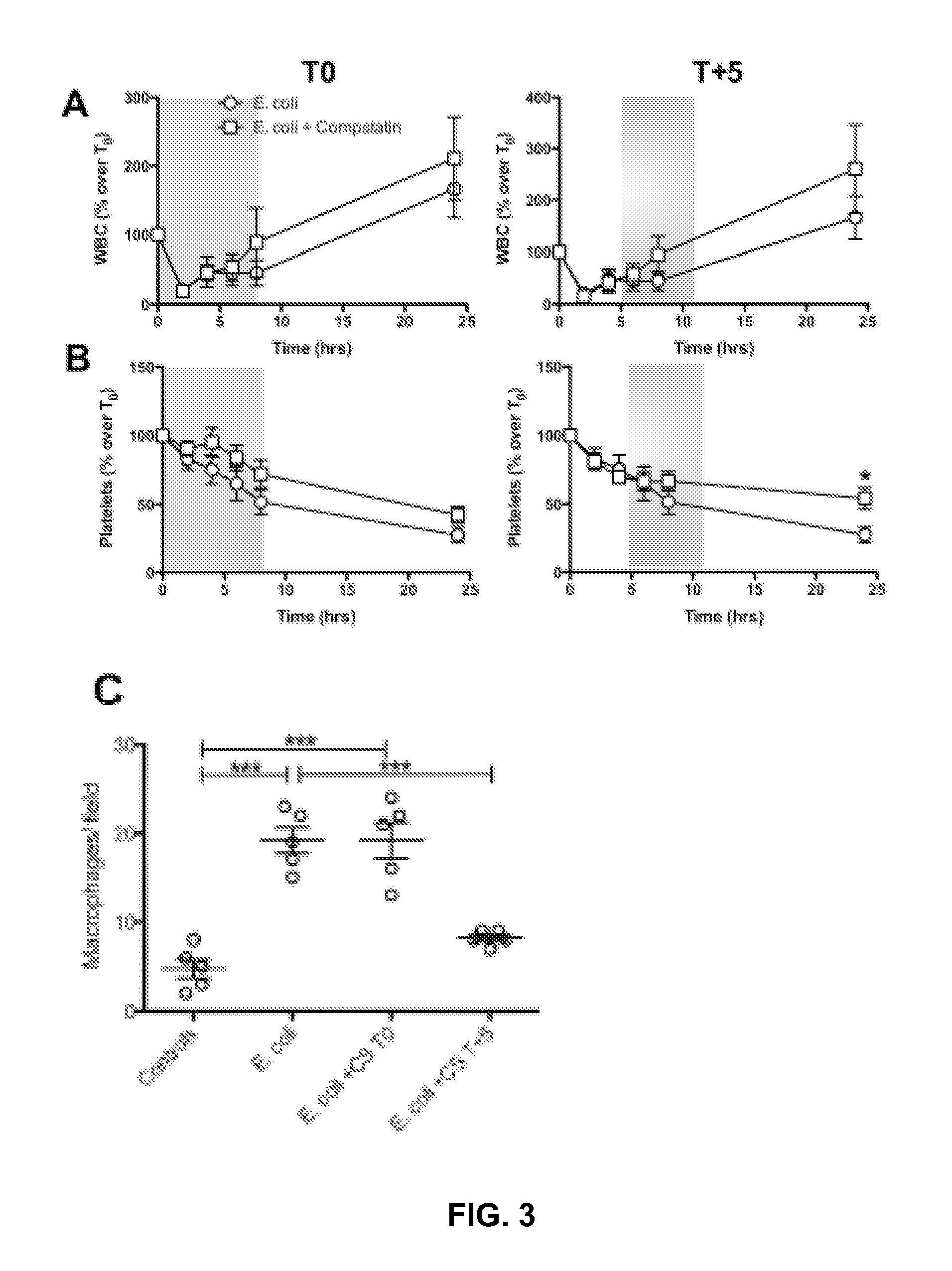Treatment Of Sepsis Using Complement Inhibitors
a complement inhibitor and sepsis technology, applied in the direction of cyclic peptide ingredients, drug compositions, peptide/protein ingredients, etc., can solve the problems of sepsis-related mortality and morbidity rates that remain unacceptably high, variant of sepsis almost always fatal, and can produce cardiovascular collapse and death within hours, so as to prevent or reduce sepsis-related extravascular cell, tissue or organ injury
- Summary
- Abstract
- Description
- Claims
- Application Information
AI Technical Summary
Benefits of technology
Problems solved by technology
Method used
Image
Examples
example 1
Materials and Methods
[0094]This example sets forth the materials and experimental methods used to generate the results described in Examples 2-6.
[0095]Reagents. Antibodies and suppliers used were as follows: rabbit anti-human neutrophil elastase (Calbiochem, San Diego, Calif.); monoclonal antibodies (mAb) anti-MHC-II, anti-CD68, anti-thrombomodulin (TM), anti-GPIIIa and rabbit polyclonal anti-human myeloperoxidase (DakoCytomation, Carpinteria, Calif.); mAb anti-tissue factor (TF, clone TF9-10H10; gift from Dr. Jim Morrissey); rabbit anti-TFPI IgG (raised and characterized in-house); mAb anti C3a (clone 4DS17.3, gift from Dr. Bo Nilsson); mAb anti-C3b (Clone C3-28, gift from Dr. Diana Wouters); mAb anti-C5b9 (clone aE11, Diatec, Oslo, Norway); mAb anti-MBL (AbD Serotec, Raleigh, N.C.); mAb anti-CD55 (Abeam Inc., Cambridge, Mass.); mAb anti-CD59 (BD Biosciences Inc., San Diego, Calif.); mAb anti-PAI1 7F5, (gift from Dr. P. DeClerck). FITC, Cy3 or Cy5 conjugated donkey anti-mouse or an...
example 2
Effect of Complement Inhibition on Markers of Complement Activation
[0109]Compstatin is a 13-residue cyclic, non-immunogenic peptide that specifically binds to primate C3, hindering the interaction of C3 with the C3 convertase complex (Janssen B J, et al., 2007, J Biol Chem. 282: 29241-29247) and thus preventing the proteolytic activation of C3. Compstatin inhibits baboon and human complement at approximately equimolar concentrations (Sahu A, et al., 2003, Molec. Immunol. 39: 557-566).
[0110]Infusion with the Compstatin analog described above rapidly inhibited C3a and C3b generation in septic baboons. Complement activity and plasma TCC levels were measured to evaluate the effect of Compstatin analog treatment on E. coli-induced complement activation. Both preventive (T0 to T+8) and rescue (T+5 to T+11) Compstatin analog treatments inhibited plasma complement activity (FIG. 1A) and plasma TCC levels, the rescue regimen averting the late rise observed in the prevention group (FIG. 1B).
[...
example 3
Effects of Complement Inhibition on Hematological Parameters
[0112]The influence of Compstatin analog treatment on hematological responses to E. coli challenge is shown in FIG. 3. E. coli infusion induced a rapid fall in leukocyte count during the first hour and a steady decline of platelets. Compstatin analog treatment led to a faster WBC recovery (FIG. 3A) and lower plasma platelet consumption (FIG. 3B) in both the prevention and rescue regimens. The higher WBC and platelet counts in blood correlated with lower accumulation of macrophages (FIG. 3C) and platelets in the lung (FIG. 3D) and on the surface of the large vessels (FIG. 3E), as well as with decreased C5b9 deposition on aggregated platelets detected in these organs (FIG. 3D-E).
PUM
| Property | Measurement | Unit |
|---|---|---|
| thick | aaaaa | aaaaa |
| blood pressure | aaaaa | aaaaa |
| concentrations | aaaaa | aaaaa |
Abstract
Description
Claims
Application Information
 Login to View More
Login to View More - R&D
- Intellectual Property
- Life Sciences
- Materials
- Tech Scout
- Unparalleled Data Quality
- Higher Quality Content
- 60% Fewer Hallucinations
Browse by: Latest US Patents, China's latest patents, Technical Efficacy Thesaurus, Application Domain, Technology Topic, Popular Technical Reports.
© 2025 PatSnap. All rights reserved.Legal|Privacy policy|Modern Slavery Act Transparency Statement|Sitemap|About US| Contact US: help@patsnap.com



